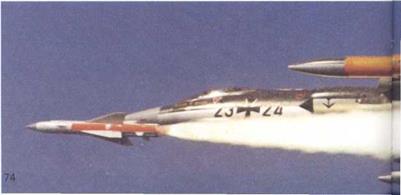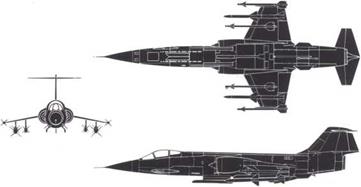Lockheed F-104 Starfighter
F-104A to G, J and S, CF-104, QF-104,
RF and RTF-104, TF-104 (data for F-104G)
Origin: Lockheed-California Co, USA: see text for multinational manufacturing programme.
Type: (A. C) single-seat day interceptor: (G) multimission strike fighter: (CF) strike-reconnaissance: (TF) dual trainer: (QF) drone RPV; (F-104S) all-weather interceptor: (RF and RTF) reconnaissance.
Engine: One General Electric J79 single-shaft turbojet with afterburner: (A) 14,8001b (6713kg) J79-3B: (C. D, F, J) 15,8001b (7165kg) J79-7A: (G, RF/RFT, CF) 15,8001b (7165kg) J79-11A: (S) 17,9001b (8120kg) J79-19 or J1Q.
Dimensions: Span (without tip tanks) 21 ft 11 in (6-68m): length 54ft 9in (16-69m): height 13ft 6in (4-11m).
Weights: Empty 14,0821b (6387kg): maximum loaded 28,7791b
(13,054kg).
Performance: Maximum speed 1,450mph (2330km/h, Mach 2-2): initial climb 50,000ft (1 5,250m)/min: service ceiling 58,000ft (17,680m) (zoom ceiling over 90,000ft, 27,400m): range with maximum weapons, about 300 miles (483km): range with four drop tanks (high altitude, subsonic) 1,380 miles (2220km).
Armament: In most versions, centreline rack rated at 2,000lb (907kg) and two underwing pylons each rated at 1,0001b (454kg): additional racks for small missiles (eg Sidewinder) on fuselage, under wings or on tips: certain versions have reduced fuel and one 20mm M61 Vulcan multi-barrel gun in fuselage: (S) M61 gun, two Sparrow and two Sidewinder.
History: First flight (X. F-104) 7 February 1954: (F-104A) 17 February 1956: (F-104G) 5 October 1960: (F-104S) 30 December 1968: final delivery from United States 1964: final delivery from Aeritalia (F-104S) 1975.
Users: Belgium, Canada, Denmark, W Germany, Greece, Italy, Japan. Jordan. Netherlands, Norway, Pakistan, Spain, Taiwan, Turkey, USA (ANG).
 |
Development: Clarence L. (‘ Kelly") Johnson planned the Model 83 after talking with fighter pilots in Korea in 1951. The apparent need was for superior flight performance, even at the expense of reduced equipment and other penalties. When the XF-104 flew, powered by a 10,5001b J65 Sapphire with afterburner, it appeared to have hardly any wing: another odd feature was the downward-ejecting seat. The production F-104A had a more powerful engine and blown flaps and after lengthy development entered limited service with Air Defense Command in 1958. Only 153 were
|
Three-view of F-104S, showing Sparrows and Sidewinders. |
built and after a spell with the Air National Guard, survivors again saw ADC service with the powerful GE-19 engine. Three were modified as Astronaut trainers with rocket boost, one gaining a world height record at nearly 119,000ft in 1963. The В was a dual tandem trainer, the C a fighter- bomber for Tactical Air Command with refuelling probe, the D a trainer version of the C and the DJ and F respectively Japanese and German versions of the D. The G was a complete redesign to meet the needs of the Luftwaffe for a tactical nuclear strike and reconnaissance aircraft. Structurally different, it introduced Nasarr multi-mode radar, inertial navigation system, manoeuvring flaps and other new items. Altogether 1,266 were built, including 970 by a NATO European consortium and 110 by Canadair. Canadair also built 200 basically similar CF-104s, while Japan built 207 J models closely resembling the earlier C. The German RF and RTF are multi – role-sensor reconnaissance and trainer versions, while increasing numbers of all versions are being turned into various QF-104 RPVs.
The only type of Starfighter built new since 1967 has been the Italian F-104S. Developed jointly by Lockheed and Fiat (Aeritalia), the S is an air – superiority fighter armed with two Sparrow air/air missiles (hence the suffix – letter S). Built under Lockheed licence, the S has a more powerful J79 engine, updated Autonetics R21G radar (with MTI, ECCM and improved reliability) and several detail changes to improve air/air role performance. The secondary ground-attack capability is retained, and in recent months the Regia Aeronautica force of 205 F-104S have begun to carry the Orpheus multi-sensor reconnaissance pod carried on the centre-line. Turkey has bought 40. followed by a second batch of the same size.
Below: Launching a Kormoran anti-ship missile from an F-104G of the West German Marineflieger. These aircraft are to be replaced by the first IDS Tornados to enter inventory service.
|
|












